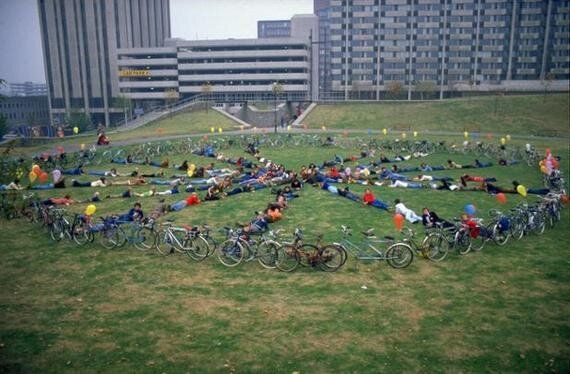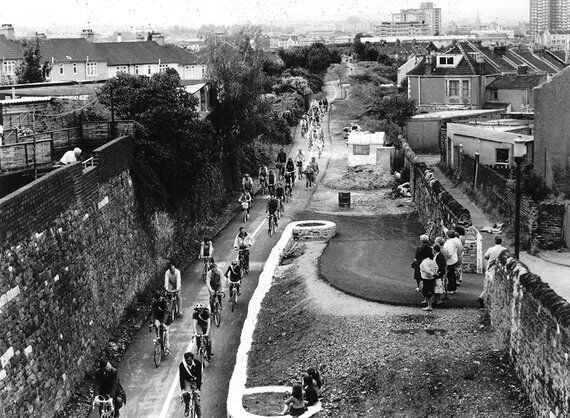
Cycling can heal inequalities yet bringing it to the people has too often been too difficult a task. But it shouldn't be.
It's not breaking news that cycling is good for you and the world around you. Alongside walking, it's part of the solution to many of the challenges we face in towns and cities today - congestion, air pollution, physical inactivity and inequalities: economic, social and health.
Lately, cycling has been found to spark a leap in property prices. A new survey conducted by Systra, the company behind the development of the Mini-Holland scheme in Walthamstow, London's latest top property hotspot, reveals that the installation of high-quality cycle infrastructure can boost house prices by 50%.
Great news as it must be for property investors, it shows there now is a tangible link between property value and cycling. It can lead to cycle infrastructure being considered on a par with motor transport infrastructure, something that the public sector has for years struggled to make a case for, despite the simple, and practical, concept of cycling - connecting people and places.
In 2007, I backed Sustrans' bid to win £50 million from the Big Lottery Fund to create 84 new walking and cycling networks. The grant meant the National Cycle Network, which the charity is the guardian of, was to be extended into the heart of communities across the UK.
Upon completion of the programme, as many as four million people enjoyed safer, cleaner and smarter journeys to work, school and for leisure, and more than a million car trips a year were no longer made.
Sustrans celebrates 40 years this year. Its anniversary, and history - so inextricably woven into the history of cycling in the UK, reminds me that enabling cycling to become an obvious and everyday, easy choice for people is still too often hindered by one-sided, short-sighted policies.
Cyclebag
When in 1977 a group called Cyclebag was formed in Bristol to respond to the growing dominance of cars on British roads, the environmental impacts of motor vehicle emissions had already been felt whilst the world had been grappling with the rocketing of oil prices in the Middle East.

Cyclebag’s 1979 rally in Castle Park, Bristol
The car's dominance was the aftermath of policies that had over 20 years facilitated the development of motorised traffic across the UK (and had led to the savage Beeching cuts which decimated Britain's national railway and many rail routes).
Cyclebag responded with a practical solution. It transformed one of the decommissioned rail routes, Bristol to Bath, into a 13-mile traffic-free bike path, showing what could be done to give some positive life back to these routes that were judged as uneconomic.
The first section of the Bristol to Bath route opened to cyclists and walkers in 1979 and it was an instant success providing an integral commuting route, an attractive leisure path and an important wildlife corridor.
It inspired the formation of similar routes across the UK, mainly using disused railways and canal towpaths; and preceded the Cycle Tracks Act of 1984 which empowered local authorities to 'convert sections of footpath to shared cycle and pedestrian use'.
A new lease of life
As Cyclebag became Sustrans and these new routes were taken forward, a new lease of life was given to the UK's fledgling cycle infrastructure - all in the midst of 'the great car economy' promise that led to Britain being called 'alongside Belgium as the worst nation for cycling,' according to a survey by European Commission in 1989.

Work started on the Bristol to Bath Railway Path in 1978
Fast forward to 2017 and we now have a National Cycle Network that includes 14,000 miles of route, and passes within one mile of half of all UK homes. Of this network, around one third is traffic free.
Cycling has now made its way into wider popular culture. It is now more acceptable, even fashionable to cycle and cycling is used to sell all manner of products, from fashion to forward thinking developments. In some parts of the UK, most obviously Central London, cycling is starting to become mainstream, with cycle flows on sections of London's Cycle Superhighways representing up to 70% of total traffic, and carrying the equivalent of one fifth of the Tube network.
However, it is in creating liveable neighbourhoods that the role of cycling and walking has the potential to have the most dramatic of impacts. In 2015, Barking and Dagenham council commissioned Sustrans to bring life (literally) to one of its housing estates, Marks Gate.
The challenges faced by the young, culturally diverse East London community ranged from poverty to high unemployment, and obesity and low activity levels. Add the car-dominated environment, and you get the picture. Gloomy as it is, it fits into national statistics, according to which the borough of Barking and Dagenham is the local authority in England with the third highest inactivity levels and the 22nd most deprived area in the UK.
By bringing people together and engaging them in street redesign, a team of engineers and bike officers helped residents build cycling and walking into their lives whilst transforming the area into a safer and a people-centred space.
The way forward
This bottom-up approach drives real change. Projects such as Marks Gate show that helping people move around (cycle and walk) can unlock the benefits that can come from a community that feels safe and empowered.
Sustrans says we can fuel our own journeys. Indeed, most journeys in towns and cities can be cycled or walked. There is a growing body of evidence demonstrating positive effects of investment in local roads and in cycling and walking infrastructure. Governments locally and nationally have a better understanding of the benefits of active travel yet investment to provide viable solutions is often absent.
Current plans up to 2020 see more than £1.1 million per mile being invested in maintaining national roads, (just 3% of all roads) yet to maintain local roads that make up 97% of England's road network, the investement is only £27,000 per mile.
The new Government ( and Governments to follow) must build on the knowledge we have and take it to the next level - bring it to life; and urban planners must ensure new developments have walking and cycling at their core for everyone, everywhere - to unpick, unlock and heal inequalities.
Let's not take the good work already being done back 40 years!
